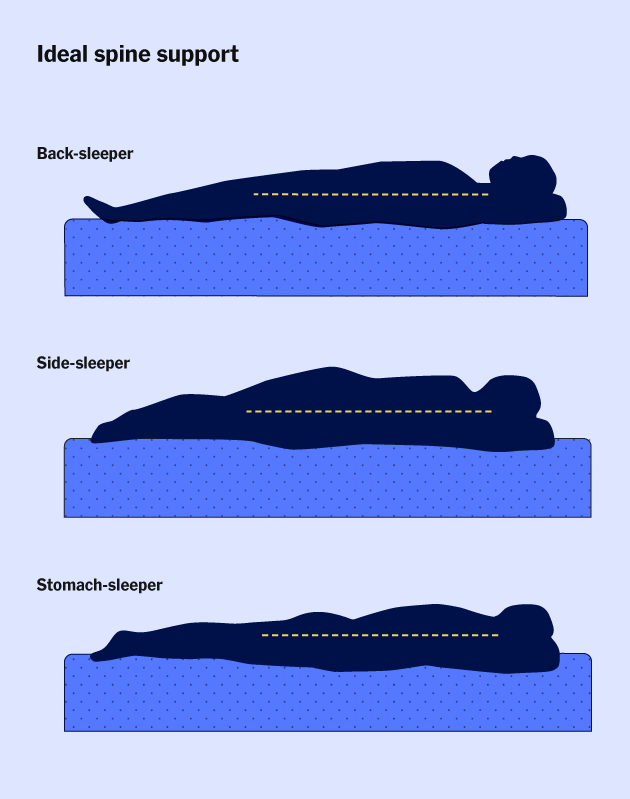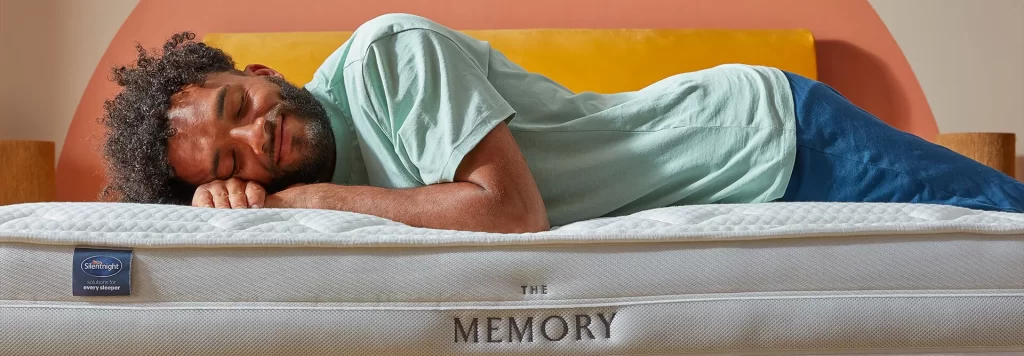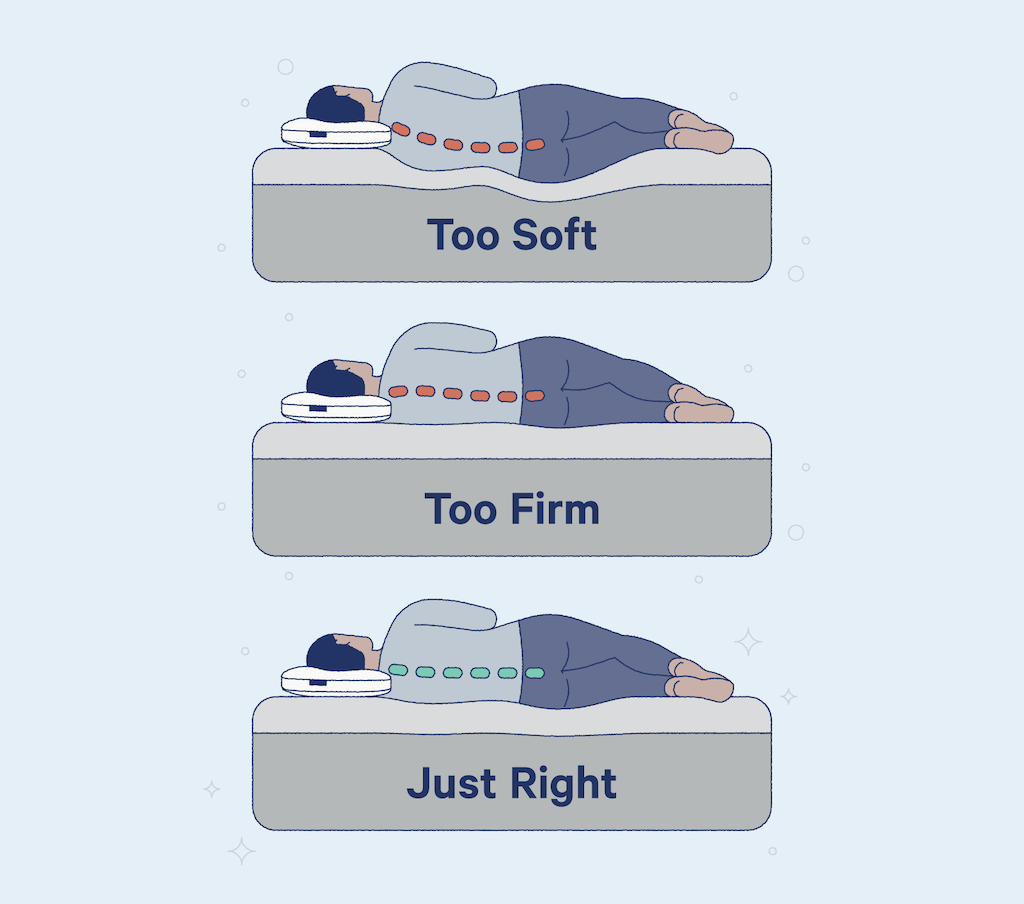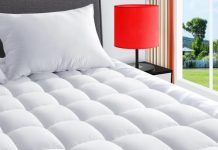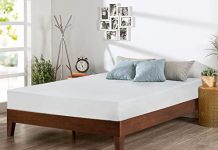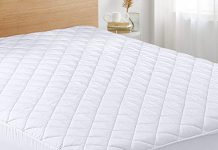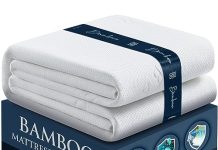If you suffer from back pain and are tossing and turning every night, desperately seeking relief, it’s time to find the perfect mattress to ease your discomfort.
With so many options, figuring out which type of mattress is best suited for your needs can be overwhelming. From memory foam to innerspring, each mattress has its advantages and drawbacks when providing much-needed support for your back.
In this article, we will explore the different types of mattresses and guide you toward the one that can offer you the most comfort and relief from your back pain.
Review contents
Memory Foam Mattress
Definition and properties of memory foam
A memory foam mattress is made from a synthetic material called viscoelastic foam. This material is known for its ability to contour to the shape of your body, providing excellent pressure relief and support. Memory foam is characterized by its ability to slowly return to its original shape, giving it the name “memory” foam. It is also known for its motion isolation properties, making it an ideal choice for couples or individuals who are easily disturbed by movement during the night. Additionally, memory foam mattresses are hypoallergenic, making them suitable for people with allergies or respiratory issues.
Benefits of using a memory foam mattress for back pain
One of the primary benefits of using a memory foam mattress for back pain is its ability to provide proper alignment and support to the spine. The contouring nature of memory foam helps alleviate pressure points on the body, allowing for natural spinal alignment and reducing strain on the back. This can help relieve back pain, especially for individuals with herniated discs or sciatica conditions.
Memory foam mattresses also excel in motion isolation, meaning movement on one side of the bed is less likely to disturb the other person. This can be particularly beneficial for those who experience back pain and are sensitive to movements during sleep.
Furthermore, memory foam mattresses are known for their ability to evenly distribute body weight, reducing pressure points and promoting healthy blood circulation. Improved blood flow can facilitate the healing process of back pain and provide relief throughout the night.
Considerations for choosing a memory foam mattress
When selecting a memory foam mattress for back pain relief, there are a few factors to consider. Firstly, the density of the memory foam is essential. Higher-density foam offers more support and durability, making it suitable for individuals with chronic back pain. Medium to high-density memory foam is generally recommended for optimal back support.
Additionally, the memory foam layer’s thickness should be considered. A thicker memory foam layer may provide cushioning and conformability, benefiting sufferers of back pain. However, it is essential to balance comfort and support, as an excessively thick memory foam layer may cause sinking and limit the support provided.
Lastly, consider the mattress cover’s breathability and hypoallergenic properties, especially if you have allergies or respiratory conditions. Look for a cover that facilitates good airflow, allowing heat to dissipate and preventing excess moisture buildup.
Latex Mattress
Definition and properties of latex
A latex mattress is made from natural or synthetic latex, a milky substance derived from the sap of rubber trees. Natural latex is desired for its eco-friendly nature and resilience, while synthetic latex is a more affordable alternative. Latex mattresses are known for their responsiveness and bounce, offering a unique combination of comfort and support.
Latex mattresses provide a balanced level of firmness, providing gentle support without sacrificing comfort. They have a natural springiness that helps distribute body weight evenly, relieving pressure points and promoting healthy sleep. Additionally, latex mattresses have excellent breathability, allowing heat to escape and keeping sleepers cool throughout the night.
Benefits of using a latex mattress for back pain
The bounce and responsiveness of latex mattresses can be beneficial for individuals with back pain. The buoyancy of latex allows for easy movement and repositioning during sleep, reducing the likelihood of waking up in uncomfortable positions or experiencing restricted mobility.
Latex mattresses are also known for their durability. They have a longer lifespan than other mattress types, making them a cost-effective option for those seeking relief from back pain in the long run. The inherent resilience of latex helps maintain its shape and support over time, ensuring consistent pressure relief for your back.
Another advantage of latex mattresses is their hypoallergenic properties. Natural latex is resistant to dust mites and mold, making it suitable for individuals with allergies or respiratory issues. Latex mattresses also have antimicrobial properties, creating a healthier sleeping environment and reducing the risk of allergic reactions.
Considerations for choosing a latex mattress
When choosing a latex mattress for back pain relief, consider the firmness level that best suits your needs. Latex mattresses are available in various firmness options, ranging from soft to firm. Individuals with back pain often find medium-firm to firm mattresses most supportive. However, it ultimately comes down to personal preference and comfort, so it’s essential to test different firmness levels and choose the most comfortable.
Additionally, consider the type of latex used in the mattress. Organic or natural latex is derived from rubber tree sap and is more environmentally friendly. It tends to have a more breathable and moisture-wicking property compared to synthetic latex. However, synthetic latex can be a more affordable option for those on a budget.
Lastly, consider the thickness and layer composition of the latex mattress. A thicker latex layer generally provides more support and pressure relief, but it may also affect the overall firmness and feel of the mattress. Look for a mattress that balances comfort, support, and durability.
Innerspring Mattress
Definition and properties of innerspring mattresses
Innerspring mattresses are constructed with a steel coil support system at the core, surrounded by comfort layers such as foam or fabric. The number, type, and arrangement of coils can vary, influencing the overall support and feel of the mattress. Innerspring mattresses are known for their responsiveness, breathability, and affordability.
The coil support system in an innerspring mattress provides a firm and supportive foundation. The springs or coils work together to distribute body weight evenly, supporting the spine’s natural curvature. This can help alleviate back pain by reducing pressure points and promoting healthy spinal alignment.
Innerspring mattresses also offer excellent breathability due to the open structure of the coil system. The gaps between the springs allow for airflow, keeping the mattress cool and preventing the buildup of heat and moisture during sleep.
Benefits of using an innerspring mattress for back pain
One of the main benefits of using an innerspring mattress for back pain is the firm support it provides. The coil system offers a solid foundation that can help maintain proper spinal alignment and reduce stress on the back. The responsiveness of the springs also allows for easy movement and repositioning during sleep, which can be beneficial for individuals with back pain.
Innerspring mattresses tend to have a more traditional and familiar feel. If you prefer a mattress with a bit of bounce and responsiveness, an innerspring mattress might be a suitable option. The coil system provides the desired level of support without sacrificing comfort.
Another advantage of innerspring mattresses is their affordability. If you are on a budget but still want a mattress that can alleviate back pain, an innerspring mattress can be a cost-effective solution. They are widely available in various price ranges, allowing you to find a suitable option without breaking the bank.
Considerations for choosing an innerspring mattress
When selecting an innerspring mattress for back pain relief, consider the coil system and its construction. The number, type, and arrangement of coils can influence comfort, support, and durability. Pocketed coils, also known as individually wrapped coils, offer better motion isolation and contouring compared to traditional Bonnell or continuous coils.
Additionally, pay attention to the gauge or thickness of the coils. Thicker coils tend to be more durable and supportive, making them a suitable choice for individuals with back pain. However, keep in mind that the firmness of the mattress can also be influenced by other factors such as the padding and comfort layers.
Furthermore, consider the quality of the comfort layers and padding surrounding the coil system. These layers can affect the overall comfort and support provided by the mattress. Look for high-quality foam or fiber padding that offers adequate cushioning and pressure relief for your back.
Hybrid Mattress
Definition and properties of hybrid mattresses
A hybrid mattress combines the benefits of multiple materials, typically memory foam or latex, with an innerspring coil system. This combination aims to provide each material’s advantages while minimizing its drawbacks. Hybrid mattresses are designed to offer a balanced feel of contouring, responsiveness, and support.
The comfort layer of a hybrid mattress often consists of memory foam or latex, providing pressure relief and conformability. This layer helps alleviate back pain by contouring to your body’s shape and distributing weight evenly. The coil support system provides stability, support, and enhanced breathability.
Benefits of using a hybrid mattress for back pain
Hybrid mattresses offer the benefits of memory foam or latex and innerspring mattresses, making them an attractive option for those seeking relief from back pain. Combining contouring materials, such as memory foam or latex, with a supportive coil system provides a balanced level of comfort and support.
The memory foam or latex layer in a hybrid mattress helps relieve pressure points, enabling better spinal alignment and reducing strain on the back. This can alleviate back pain and promote a more restful sleep. The coil system adds firmness and support, improving the overall stability of the mattress and preventing excessive sinking.
Another advantage of hybrid mattresses is their enhanced breathability. The coil system increases airflow, reducing heat retention and providing an excellent sleeping surface. This can particularly benefit individuals who sleep hot or experience night sweats, as excessive heat can exacerbate back pain.
Considerations for choosing a hybrid mattress
When choosing a hybrid mattress for back pain relief, consider the materials used in the comfort layer. Different types of memory foam or latex may have varying contouring, responsiveness, and durability levels. Opt for high-quality materials that offer optimal support and pressure relief for your back.
Pay attention to the coil system’s quality and construction, as this will largely determine the mattress’s overall stability and support. Individually wrapped or pocketed coils can provide better motion isolation and contouring than traditional coil systems.
Additionally, consider the thickness and arrangement of the comfort and support layers. The balance between the memory foam or latex and the coil system can affect the overall feel and firmness of the mattress. Test different options to ensure that the hybrid mattress provides the right combination of comfort and support for your back pain relief needs.
Orthopedic Mattress
Definition and properties of orthopedic mattresses
Orthopedic mattresses are explicitly designed to support the spine and alleviate back pain. These mattresses aim to provide targeted support by taking into account the natural alignment of the body. Orthopedic mattresses often have a combination of firmness levels and additional support features to promote healthy sleep posture.
Orthopedic mattresses typically feature high-density materials such as memory foam or latex, known for their ability to contour to the body and relieve pressure points. These mattresses are also reinforced with extra support layers to ensure optimal spinal alignment and support.
Benefits of using an orthopedic mattress for back pain
One of the main benefits of using an orthopedic mattress for back pain is the targeted support it provides to the spine. These mattresses are specifically designed to align the spine properly, reducing pressure points and promoting a healthy sleep posture. By maintaining the natural curvature of the spine, orthopedic mattresses can help alleviate back pain and prevent further discomfort.
Orthopedic mattresses are often made from high-density materials such as memory foam or latex, which offer excellent contouring and pressure relief. The ability of these materials to mold to the body’s shape helps distribute weight evenly and reduce strain on the back. This can lead to improved spinal alignment and reduced back pain during sleep.
Additionally, orthopedic mattresses have extra support features to reinforce the lumbar region and other critical areas. These additional layers or zones provide targeted support where it is most needed, further aiding in back pain relief.
Considerations for choosing an orthopedic mattress
When selecting an orthopedic mattress, consider the firmness level that best suits your needs. Orthopedic mattresses are available in different firmness levels, ranging from medium-firm to extra-firm. Medium-firm mattresses are often recommended for back pain relief as they provide a balance between comfort and support.
Pay attention to the materials used in the mattress, particularly the comfort layers. Memory foam or latex is often favored for its contouring and pressure-relieving properties. Look for high-density foam or natural latex that offers adequate support and durability.
Furthermore, consider the additional support features incorporated into the mattress. Some orthopedic mattresses have reinforced lumbar zones or targeted support layers to provide extra support where needed most. Assess your specific back pain concerns and choose a mattress that addresses those areas effectively.
Adjustable Bed Mattress
Definition and properties of adjustable bed mattresses
Adjustable bed mattresses are specifically designed to be used in conjunction with adjustable bed frames. These flexible mattresses can be adjusted to different positions, allowing you to find the most comfortable angle for your back pain relief. They are typically made from memory foam, latex, or innerspring.
The main feature of adjustable bed mattresses is their ability to conform to the different positions of an adjustable bed frame. They are often divided into sections or panels to allow for independent movement and flexibility. This enables you to elevate or lower specific mattress areas to alleviate pressure points and find optimal support for your back.
Benefits of using an adjustable bed mattress for back pain
One of the primary benefits of using an adjustable bed mattress for back pain is the ability to customize your sleeping position. Adjustable beds allow you to elevate or lower specific areas of the mattress, providing support and relief to targeted areas of your body. Adjusting the bed to a more elevated position can reduce strain on your back and promote proper spinal alignment.
Adjustable bed mattresses also offer excellent pressure relief due to their flexible nature. You can raise the head and foot sections of the bed to relieve pressure on your back, hips, and joints. This can aid in back pain relief by reducing the strain on your spine and promoting circulation.
Additionally, adjustable bed mattresses can aid in reducing snoring and sleep apnea, which are often associated with back pain. Raising the upper body can open airways and improve breathing, leading to better sleep and decreased back pain.
Considerations for choosing an adjustable bed mattress
When selecting an adjustable bed mattress for back pain relief, consider the materials used and their flexibility. Memory foam and latex mattresses are better suited for adjustable beds due to their ability to conform to different positions effectively. Innerspring mattresses can also be used, but they may be less responsive to movement compared to foam or latex.
Pay attention to the mattress’s flexibility and how it adjusts to the different positions of an adjustable bed frame. Look for a mattress that maintains its structural integrity and support even when adjusted. Some mattresses may have specialized designs or materials for better conformity and responsiveness.
Ensure the mattress has compatible dimensions with your adjustable bed frame to ensure a proper fit. Some adjustable bed frames have specific mattress thickness or compatibility requirements, so it’s vital to check those specifications before purchasing.
Firmness Levels
Importance of firmness in alleviating back pain
The firmness level of a mattress plays a crucial role in alleviating back pain. While personal preference will vary, choosing a mattress that provides adequate support without sacrificing comfort is generally recommended. A mattress that is too soft can cause the body to sink, leading to improper spinal alignment and increased pressure on the back. On the other hand, a mattress that is too firm may not offer enough contouring and pressure relief, resulting in discomfort and potential exacerbation of back pain.
Optimal spinal alignment is crucial for back pain relief and prevention. A mattress with the right level of firmness can help maintain the spine’s natural curvature, preventing strain and reducing pressure points. It promotes alignment from the neck to the lower back, allowing the muscles to relax and recover during sleep.
Determining the optimal firmness level for individual needs
Determining the optimal firmness level for your individual needs can be subjective, as it varies based on personal preference and body type. However, there are general guidelines that can help you choose the right firmness level to alleviate back pain.
For individuals with back pain, medium-firm to firm mattresses are often recommended. These mattresses balance support and comfort, ensuring that the spine remains adequately aligned throughout the night. The medium-firm level allows for some contouring and cushioning without compromising support. In contrast, the firm level provides a solid and supportive surface for those who prefer a more rigid feel.
Remember that your body weight and preferred sleeping position should also be considered when determining the optimal firmness level. Individuals with a higher body weight may require a firmer mattress to provide adequate support, while lighter individuals might find a medium-firm mattress more suitable. Additionally, side sleepers benefit from slightly softer mattresses to alleviate pressure on the shoulders and hips. Back or stomach sleepers often prefer firmer mattresses to maintain proper spinal alignment.
Different firmness options available in mattresses
Mattresses come in various firmness options to cater to different preferences and needs. The most common firmness levels are soft, medium-soft, medium, medium-firm, and firm.
- Soft: Soft mattresses offer the highest level of sinkage and contouring. They provide a plush and cushioned feel, suitable for individuals who prefer a more “hugged” sensation during sleep. Soft mattresses may not provide sufficient support for back pain relief but can be suitable for individuals with low body weight or specific comfort preferences.
- Medium-soft: Medium-soft mattresses offer a balance of cushioning and support. They provide some contouring and sinkage while still maintaining a level of firmness. These mattresses are often recommended for side sleepers who require more pressure relief for their shoulders and hips.
- Medium: Medium mattresses strike a balance between contouring and support. They offer a moderate level of sinkage while maintaining a solid foundation. Medium mattresses are versatile and suitable for various sleeping positions, making them popular for back pain relief.
- Medium-firm: Medium-firm mattresses provide a slightly firmer feel with minimal sinkage. They offer a good compromise between support and comfort, making them suitable for individuals who prefer a more solid sleeping surface. Medium-firm mattresses are often recommended for back sleepers or those with back pain.
- Firm: Firm mattresses provide minimal sinkage and a solid sleeping surface. They offer the highest level of support and are often favored by stomach sleepers or individuals with higher body weight. Firm mattresses may not provide sufficient contouring for pressure relief but can promote proper spinal alignment.
When selecting a mattress, it’s essential to test different firmness options to determine which one feels most comfortable and supportive for your back pain relief.
Sleeping Positions
Impact of sleeping positions on back pain
Sleeping positions can significantly influence back pain and the overall quality of sleep. Each sleeping position places different demands on the body and affects the alignment of the spine. Understanding the impact of sleeping positions can help you choose a mattress that provides adequate support and pressure relief.
- Back sleeping: Sleeping on your back is generally considered the best position for back pain relief. It allows for proper spinal alignment and distribution of body weight. When sleeping on your back, it’s essential to have a mattress that supports the spine’s natural curvature and provides adequate lumbar support.
- Side sleeping: Side sleeping is a common position that can also alleviate back pain. However, it requires proper support to maintain spinal alignment. By ensuring that the mattress contours to the body’s curves and provides cushioning for the shoulders and hips, side sleepers can reduce pressure points and prevent spinal misalignment.
- Stomach sleeping: Sleeping on your stomach is generally not recommended for back pain relief, as it can strain the neck, shoulders, and lower back. However, if you prefer this position, it’s essential to have a mattress that offers sufficient support and prevents excessive sinking. Firm mattresses are often recommended for stomach sleepers to maintain proper spinal alignment.
Recommended mattresses for different sleeping positions
To choose a mattress based on your sleeping position, consider the following recommendations:
- Back sleeping: A medium-firm to firm mattress is generally recommended for back sleepers. This type of mattress provides ample support to maintain the natural curvature of the spine and evenly distribute body weight. Look for a mattress with good lumbar support to alleviate strain on the lower back.
- Side sleeping: Side sleepers typically benefit from a medium to medium-soft mattress. This allows for proper contouring and pressure relief, especially around the shoulders and hips. Look for a mattress with sufficient cushioning to prevent pressure points and promote spinal alignment.
- Stomach sleeping: Stomach sleepers generally require a firmer mattress to prevent excessive sinking and maintain proper spinal alignment. A medium-firm to firm mattress can offer the necessary support for this sleeping position. Look for a mattress with minimal contouring to prevent the back from sinking too much and straining the lower back.
While these recommendations are a general guideline, it’s important to prioritize personal comfort and feel. Testing different mattresses and adjusting firmness levels based on your needs and preferences can help you find the best mattress for your sleeping position.
Considerations for choosing a mattress based on sleeping positions
When choosing a mattress based on your sleeping position, there are a few factors to consider:
- Support: Regardless of your sleeping position, choosing a mattress that offers adequate support is crucial. Look for a mattress that maintains proper spinal alignment, supports the spine’s natural curvature, and alleviates pressure points.
- Contouring: Different sleeping positions require different levels of contouring. Side sleepers often benefit from more contouring to relieve pressure on the shoulders and hips, while back and stomach sleepers may prefer less contouring to maintain proper alignment.
- Transitional support: Transitional support refers to how well the mattress adapts to different movements and changes in sleeping positions. A mattress with good transitional support ensures that your body remains aligned and supported as you shift positions during sleep.
- Edge support: Edge support is significant for individuals who sit or sleep near the edge of the bed. A mattress with solid edge support prevents sagging and maintains stability, allowing you to utilize the mattress surface fully.
By considering these factors and selecting a mattress that caters to your specific sleeping position needs, you can enhance your overall sleep quality and alleviate back pain.
Material Durability
Importance of mattress durability for back pain relief
Mattress durability is essential for back pain relief, ensuring consistent support, pressure relief, and proper spinal alignment. A durable mattress maintains its structural integrity over time, preventing sagging and minimizing the risk of developing new aches or pains.
When a mattress loses its durability, it can lead to uneven wear and inadequate support for the body. This can result in improper spinal alignment, increased pressure points, and exacerbated back pain. A durable mattress, however, provides consistent support and cushioning, reducing strain on the back and promoting a healthier sleep posture.
Common materials used in mattresses and their durability
Different mattress materials have varying levels of durability. Here are some common materials used in mattresses and their characteristics:
- Memory foam: Memory foam mattresses are known for their excellent conforming ability and pressure relief. However, the durability of memory foam can vary depending on its density. Higher-density memory foam offers better support and durability, making it more suitable for individuals with back pain.
- Latex: Latex mattresses are highly resilient and known for their durability. Natural latex mattresses, in particular, can last longer than synthetic ones. Latex offers excellent contouring and pressure relief, making it popular for individuals seeking back pain relief without sacrificing longevity.
- Innerspring: Innerspring mattresses typically consist of a coil support system with comfort layers. The durability of an innerspring mattress largely depends on the quality of the coil system. Look for mattresses with high-quality coils, such as individually wrapped or pocketed coils, as they tend to be more durable and provide better support.
- Hybrid mattresses combine different materials, typically memory foam or latex with an innerspring coil system. The durability of a hybrid mattress depends on the quality and resilience of the individual components. Look for high-density memory foam or natural latex with durable coils for long-lasting support and comfort.
Tips for selecting a durable mattress for back pain
When selecting a durable mattress for back pain relief, consider the following tips:
- Choose high-density foam or latex: Opt for mattresses with high-density memory foam or natural latex. These materials tend to offer better longevity and support. Higher density foam or latex mattresses maintain their shape and structural integrity for an extended period, providing consistent support for the back.
- Consider the coil system: If you prefer an innerspring or hybrid mattress, pay attention to the coil system’s quality. Individually wrapped or pocketed coils tend to be more durable and provide better support compared to traditional Bonnell or continuous coils.
- Read customer reviews: Customer reviews can provide insights into the durability and longevity of a mattress. Look for feedback on how well the mattress has maintained its support and comfort.
- Check the warranty: A mattress warranty can indicate its durability and expected lifespan. Look for mattresses with extended warranty periods, often indicating that the manufacturer has confidence in the product’s durability.
By considering these tips and choosing a mattress with high-quality materials and components, you can increase the likelihood of finding a durable mattress that provides long-lasting back pain relief.
Frequently Asked Questions
Can a mattress help with back pain?
Yes, a mattress can play a significant role in alleviating back pain. A supportive and pressure-relieving mattress can help maintain proper spinal alignment and reduce strain on the back. Different mattress types, such as memory foam, latex, innerspring, hybrid, and orthopedic mattresses, offer specific benefits for back pain relief. By choosing the right mattress with proper support and cushioning, you can improve your sleep quality and reduce back pain.
What mattress firmness is best for back pain?
The best mattress firmness for back pain varies based on individual preferences and needs. However, medium-firm to firm mattresses are generally recommended for back pain relief. These firmness levels balance support and comfort, providing proper spinal alignment and reducing pressure points. It’s essential to test different firmness levels and choose the most comfortable and supportive for your back pain relief.
How often should I replace my mattress to alleviate back pain?
There is no set timeframe for when a mattress needs to be replaced, as it depends on various factors, such as the quality of the mattress, its materials, and individual usage. However, a general guideline is to consider replacing your mattress every 8-10 years.
Over time, mattresses can lose their durability and support, leading to increased back pain. If you notice significant sagging, uneven wear, or increased discomfort, it may be time to invest in a new mattress for optimal back pain relief.
Are there other factors besides the mattress that can help with back pain?
Other factors can help with back pain relief besides choosing the right mattress. Maintaining a proper sleep posture, exercising regularly to strengthen core muscles, managing stress levels, maintaining a healthy weight, and using ergonomic pillows and sleep accessories can all relieve back pain.
Adopting a holistic approach and addressing lifestyle factors contributing to your back pain is essential. Consulting with a healthcare professional or a sleep specialist can also provide valuable guidance in managing back pain.


